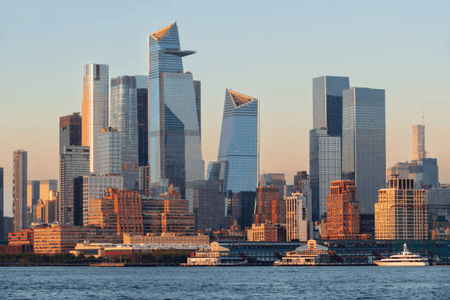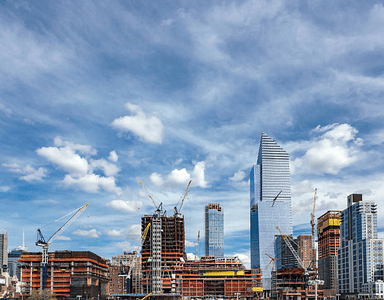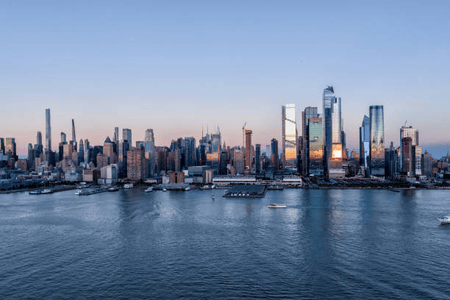The History of Hudson Yards
In the heart of New York City, a transformation is underway that has reshaped the skyline and brought a fresh dimension to the local architectural identity. Just a few short years ago, an underutilized stretch of land near the western edge lay dormant, overshadowed by its more famous neighbors. Yet, today, it stands as one of the most ambitious urban revitalization projects in the world. This is the story of how Hudson Yards, once an industrial wasteland, evolved into a beacon of modern thinking, where cutting-edge design meets forward-thinking planning.
The area that would become Hudson Yards began as an industrial zone in the 19th century, a vital part of the local trade economy. Railroads snaked through, transporting goods from the bustling ports, and warehouses filled the scene. But as the city’s needs shifted in the mid-20th century, the once-thriving industrial district slowly became obsolete. The trains that had powered the nearby economy were replaced with more efficient modes of transport, and the land itself grew neglected, a forgotten part of the metropolitan sprawling urban landscape.
As the years passed, the West Side of Manhattan started to feel the effects of this change. Once a site teeming with activity, it became an increasingly underdeveloped and disconnected part of the region. Amidst this, visionaries started to see potential where others saw only rusted tracks and abandoned warehouses. The West Side could become a center of life, a bustling hub that would complement the already bustling downtown.
In the early 2000s, as Manhattan faced the dual challenges of congestion and a lack of available space for development, the idea of creating a sustainable neighborhood took shape. Metropolitan planners, architects, and developers started to envision a massive, transformative project: a community that would redefine the skyline and offer a model for 21st-century living.
But this wasn't just about adding another commercial district. The vision for the region was about creating an updated place—one that combined offices, residences, cultural institutions, and public parks. It was to be a vertical city, designed to take advantage of the limited space available in one of the world’s most expensive and densely populated cities. The challenge would not be easy: how to build in such a crowded area, while maintaining character, all without losing sight of the human element.
The project’s scope was nothing short of extraordinary. Spanning 28 acres, the construction would require complex engineering, innovative construction techniques, and a reimagining of what modern locations could be. The foundation alone would be a feat of engineering. Since the land was built over the old rail yards, it had to be reinforced to support the weight of the new buildings. Hundreds of piles were driven deep into the ground to anchor the structures, while enormous platforms were built to provide a stable base for what would become some of the megalopolis’ tallest and most striking buildings.
In the early years of construction, the plan was largely focused on laying the groundwork—quite literally. But as the platform took shape and the project began to rise, it was clear that the vision was becoming reality. The neighborhood emerged as a beacon of innovation, capturing the imagination of architects, planners, and residents alike.
What set Hudson Yards apart from many other urban developments was its bold and futuristic approach to design. The architecture was meant to complement the existing cityscape while making a statement of its own. Towers with shimmering glass facades reached toward the sky, reflecting the changing light and becoming an iconic part of the skyline. The streets and open settings were designed with an emphasis on pedestrian experience, creating a growing sense of connection between buildings and nature.
At the heart of the growth is a multi-level public spot that invites visitors and residents to explore and enjoy the town in new ways. The sprawling parkland, with its lush greenery and up-to-date amenities, offers a peaceful retreat from the hustle and bustle of the metropolitan environment. Thoughtful landscaping, public art, and open plazas have created a space that feels both vibrant and serene, with ample opportunities for recreation, relaxation, and cultural engagement.
As construction continued, more and more of the development’s vision took form. The first major pieces were completed in phases, with each building adding a layer of complexity and beauty. Energy and life were brought in as residential towers rose from the ground. High-end retail locations were introduced, offering a shopping experience unlike any other in the city. Restaurants, cafes, and galleries populated the neighborhood, infusing the setting with culture and vibrancy. What was once an industrial wasteland was becoming a sought-after destination for both residents and visitors.
One of the most notable features is the focus on sustainability. Every aspect of the plan was carefully considered with the environment in mind. From energy-efficient systems to the use of environmentally friendly materials, they set a standard for eco-conscious growth. Green roofs, renewable energy sources, and extensive recycling programs are just a few of the ways the project contributes to a more sustainable future.
Another hallmark of the redevelopment is its integration with the surrounding region. The expansion was designed not only to be a destination in itself but also to enhance the broader inner-city environment. Streets were redesigned to improve pedestrian flow, public transportation options were expanded, and connections were made to neighboring districts, creating a seamless transition between classic and contemporary. This thoughtful integration with the existing infrastructure ensures that it will remain a vital part of the district for years to come.
As it continued, it became clear that Hudson Yards was more than just a real estate project—it was a testament to the resilience and creativity. It demonstrated that even in one of the world’s busiest and most complex urban environments, it was possible to create something truly groundbreaking. The area soon became a symbol of what Manhattan could achieve when it dared to dream big and embrace bold, innovative ideas.
Today, it stands as one of the most iconic neighborhoods in New York City. The skyline is marked by sleek towers that represent the future. It is a neighborhood that is both vibrant and welcoming, offering a place for work, play, and everything in between. The parks, public spaces, and cultural offerings make it a place where people can live, work, and interact with the local environment. What was once a forgotten corner of Manhattan has become a shining example of what happens when vision, ambition, and innovation come together.
This story is not just one of transformation—it is a reflection of Manhattan’s ever-evolving identity. It is a place where history and modernity converge, where engineering feats meet creative design, and where the future of living is being written today. In the years to come, Hudson Yards will undoubtedly continue to evolve, but it will always stand as a testament to what can be achieved when someone dares to reimagine its future.



